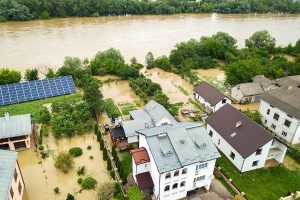
Climate change is having an impact on the number of flooding events across the world. From stronger hurricanes to rising ocean levels to more intense rain and snow events, flooding is growing in its impact on public safety. This winter's "atmospheric rivers" dumped unprecedented snow and rain on the west coast. As we move into spring and summer, those record-breaking snowpacks will melt causing huge amounts of water to run into already full lakes and rivers. Agencies at the local, state, and federal level are working to adapt decades old processes to meet the modern flood threat.
Forecasting without data
Forecasting models depend on historical data, but when you have unprecedented precipitation levels, historical data has limited impact on preparation and response plans. This lack of data is a problem even in routine weather events. There is more data for urban than rural areas thanks to the placement of radar towers, other sensors and IoT technology. This leaves blank spots in forecasting incoming weather and storm impacts for rural communities.
The National Weather Service is looking to launch a new system, the Unified Forecast System, in 2024 to address this disparity. This modeling system is a collection of 10 models, replacing the single model used today. This will introduce more statistical uncertainty into calculations, which results in a broader range of results. With this range, citizens will have a better understanding of the potential storm risks and can take appropriate precautions.
Alerting without broadband
Cellular and internet access impact how local and national weather alerts get to rural populations. A recent heavy rain event caught many people in eastern Kentucky by surprise. A review of alerting found that nearly 42 percent of households in affected counties had difficulty accessing internet, television, radio, and cell service for emergency communications during the floods.
Even when alerts are issued, many go ignored. A recent mix-up in an emergency broadcast test had alerts going to people's cell phones in the early hours of the morning. The community response to this inconvenience highlighted how many people disabled government alerts on their phones, which will greatly hamper communication in an actual emergency.
Preparing for 2023 hurricane season
Looking to meet some of the data and communication challenges, the National Oceanic and Atmospheric Administration has upgraded its Probabilistic Storm Surge model (P-Surge model) to help predict the impact of storm surges related to hurricanes. This model is used to predict how much above normal tide water will rise because of a storm. The upgrade includes new forecasts for surge, tide and waves in Puerto Rico and the U.S. Virgin Islands, the capability to run the model for two storms at the same time, and better model calculations of friction over different land surface types to more accurately compute flooding along the coast.
The P-Surge model draws historical data as well as forecast data together to create the probability for surges. This gives officials a range of potential outcomes based on the percent chance of each to help communicate predictions and worst-case scenarios.
GovEvents and GovWhitePapers have a number of resources that address how to meet the challenges of disaster preparedness and response.
- Local Government Reimagined (June 7-9, 2023; Long Beach, CA) - This conference investigates how local governments enhance the quality of life in their communities by addressing critical issues such as climate change, housing, aging infrastructure, and economic development.
- 2023 IJIS Institute Community Forum (June 13-15, 2023; Austin, TX) - Centered around critical issues that face our communities nationwide, this event will address topics including the evolution of emergency service providers' responses to situations that are both man-made and natural disasters impacting our communities and increasing the necessity for real-time data sharing to support the response.
- NENA 2023 (June 17-22, 2023; Grapevine, TX) - Hear about the public safety issues of today and tomorrow and gain practical, real-world know-how to put into action immediately.
- Four Trends Impacting Law Enforcement Technology Use (white paper) - Hear from several law enforcement technology companies and discover the realities that are shaping how the law enforcement community uses technology to meet today's public safety needs.
- Small & Rural Agency Crisis Response: A National Survey and Case Studies (white paper) - The National Policing Institute conducted a study to understand how small and rural law enforcement agencies respond to calls involving people who are in crisis. Detailed case studies were then conducted on eight of the responding agencies to identify how they respond to people in crisis, what their typical challenges are, and how they address those challenges.
- Climate Resilience: Opportunities to Improve Federal Planning and Implementation (white paper) - This paper focuses on how Congress and federal agencies can improve climate resilience planning and implementation by applying principles of GAO's Disaster Resilience Framework.
For more insights on improving public safety and weather-related disaster response, check out more resources on GovEvents and GovWhitePapers.




